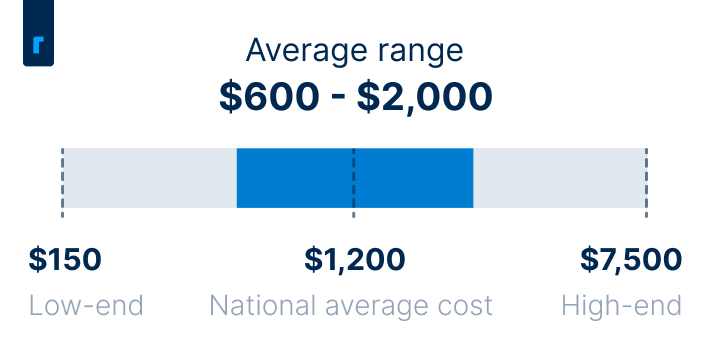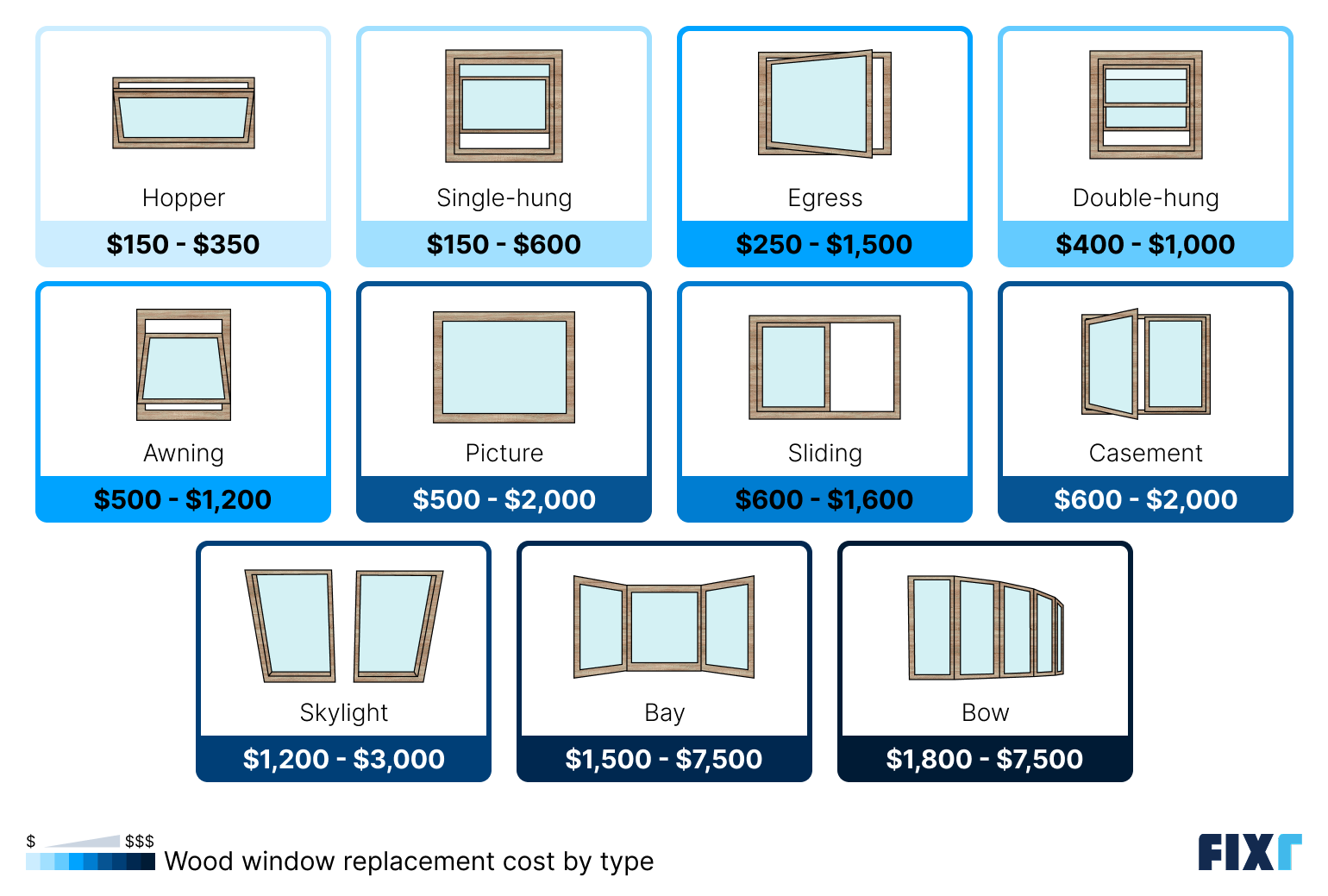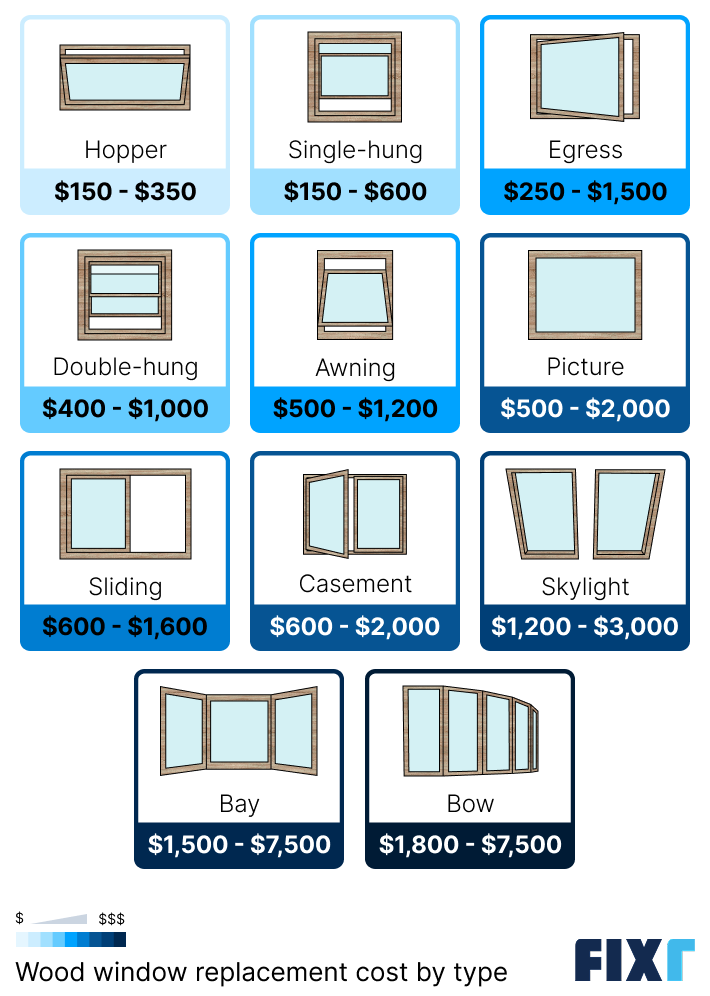Updated: November 27, 2025
Written by Dan Simms
Nieves is a home remodeling editor at Fixr.com with special interest in landscaping, pest control, painting, installation, and repair projects. She brings her work ethic, creativity, and love for teamwork into everything she does, including working with writers and designers at Fixr.com to develop useful and comprehensive guides for homeowners.
Learn moreReviewed by Nieves Martinez
Wood windows are the traditional choice for homeowners looking to maximize curb appeal and visual charm, and they also offer good energy efficiency, longevity, and durability. Wood windows are easy to repair, so while they cost more than windows with other frame materials, like vinyl and aluminum, it’s possible to get more value from them in the long run.
The national average cost of wooden windows is $1,200 per window. Most homeowners pay somewhere between $600 and $2,000 per window, but prices vary widely based on many factors. Your exact costs will depend on the type and size of the window you’re replacing, the location in your home, your geographic location, and how many windows you need replaced.
Wood Replacement Windows Cost


Wood Replacement Windows Cost Factors
You could pay as little as $150 per wood window or as much as $7,500. There are many factors you should consider to determine where in that range your per-window cost will fall.
Window Type
The type of window you need is the most impactful cost factor to think about. Small, simple hopper windows are the most affordable and may cost just $150 each. Larger bay windows require more materials to manufacture and often require multiple installers to maneuver them into place safely, so material and labor costs will be much higher. Bigger windows will always be more expensive, as will windows with complex opening mechanisms, like casement windows.


Window Type | Average Cost |
Hopper | $150 – $350 |
Single-hung | $150 – $600 |
Egress | $250 – $1,500 |
Double-hung | $400 – $1,000 |
Awning | $500 – $1,200 |
Picture | $500 – $2,000 |
Sliding | $600 – $1,600 |
Casement | $600 – $2,000 |
Skylight | $1,200 – $3,000 |
Bay | $1,500 – $7,500 |
Bow | $1,800 – $7,500 |
Wood Species
Wood windows are traditionally made from pine or oak, but there are many different species to choose from. The species you pick will affect your upfront costs, as well as window longevity, weather resistance, rot resistance, and even energy efficiency.
Pine and Douglas fir are the most affordable options, but hardwoods like oak, mahogany, walnut, cherry, maple, and teak will usually last longer, offer better weather resistance, and provide more curb appeal.
Wood Species | Average Cost |
Pine | $650 – $2,000 |
Douglas fir | $700 – $2,000 |
Oak | $700 – $2,400 |
Maple | $700 – $2,600 |
Cherry | $800 – $2,800 |
Mahogany | $800 – $2,800 |
Walnut | $1,000 – $2,600 |
Teak | $1,400 – $3,000 |
Number of Windows
The number of windows you’re replacing can affect both material and labor costs. Many window manufacturers will offer per-window discounts if you purchase multiple windows at once. The average cost of replacing wood windows is $1,200, but replacing 10 or more windows at once could bring the cost per window down by around 20%.
Window Size
The size of your window will have an impact on both material and labor costs. Larger wood windows require more frame material and more glass, pushing material costs higher. Larger wood windows, especially bay and bow windows, will also require multiple installers on-site to maneuver and lift the window into place, which means your labor costs could double or triple as opposed to what you’d pay for a single installer to put in a new wood hopper window.
Window Size | New Wood Window Cost |
Small | $150 – $1,200 |
Medium | $400 – $3,000 |
Large | $800 – $7,500 |
Number of Panes
The type of glass you choose for your windows will play an important role in your total cost. Double-pane glass is the most common, as it strikes a good balance between upfront cost and energy efficiency. Double-pane windows have two panes of glass with a layer of insulative gas sealed between them. This improves efficiency and also reduces the outdoor noise that enters your living space.
Single-pane windows are more affordable, but they’re far less efficient and really only suitable for homes in mild climates. Upgrading to triple-pane glass will maximize energy efficiency and sound dampening, but it will also significantly increase your per-window cost.
Labor
On average, you can expect to pay between $150 and $300 for labor to replace wood windows. Labor costs can increase dramatically for larger windows that require multiple installers working to move your window into place. You’ll also pay more for installations on your second floor, especially if the window is heavy and requires a crane or window lift to move it into place.
Labor costs also vary based on your geographic location, as they usually scale with the local cost of living. You should expect to pay higher costs if you live in or near a major city or in a more expensive state.
Accessibility
The location of your window in your home and how accessible the area is can have an effect on your labor costs. Windows on the second floor that require special equipment to maneuver into place will usually drive labor costs higher. Similarly, windows located above garden beds, behind nearby trees, or over landscaping features or outbuildings can complicate the installation and push labor costs higher.
Additional Considerations and Costs
There are several other factors you should consider to get the most accurate estimate possible and to avoid surprise charges on your estimate or final invoice.
Framing adjustments: If you need to resize the wall opening to fit a different window size, expect to add a few hundred dollars to your total.
Disposal fees: Most window contractors will include the cost of removing your old window in their estimates, but some may charge separately to haul away the window and dispose of it. If yours does, expect your total to increase by between $50 and $200.
Permits and inspection fees: In most cases, you’ll need a permit for window replacement. Depending on where you live, permit fees could range from $50 to $300.
Custom vs. prefab windows: Prefab windows will always cost less than custom ones because the manufacturing costs are much lower. Custom windows can drive your total up by hundreds or even thousands of dollars.
Hidden repairs: Once the old window is removed, your installer may uncover water damage, mold, or pest issues. Repairs could add hundreds or even thousands to your total, depending on the severity of the damage.
Window upgrades: Add-ons like low-emissivity (low-E) coatings or window tinting for improved energy efficiency, or tempered or laminated glass for added safety or security, can add hundreds to your per-window costs.
Clad windows: Wood-clad windows have exposed wood frames on the interior but are covered in vinyl, aluminum, or fiberglass on the outside for added weather resistance. Clad windows can improve window longevity and energy efficiency, but they will add to your material costs.
DIY vs. Hiring a Pro
It’s possible to DIY window installation, and doing the work yourself may save you a few hundred dollars. However, it’s always best to leave window replacement to a professional. It’s easy to make mistakes, and even minor errors can lead to major property damage from water leaks or higher utility bills from air leaks.
It’s especially important to hire a pro for safety reasons if you’re installing a larger window, like a bay window or bow window, or if you’re replacing a window on the second floor. Doing the work yourself is dangerous and could result in damage to your window if you drop it.
Repair vs. Replacement
If you’re experiencing an issue with your existing window, you may want to consider whether a window repair or a full replacement is a better option. Window repair costs an average of $400, while a total replacement will cost an average of $1,200. A repair can make sense for minor issues, like damaged hardware, small cracks, or isolated seal failures, especially if the window is still relatively new and structurally sound.
However, it’s not always in your best interest to go with the cheaper option. You’ll likely save money on future repairs, potential property damage, and even utility bills by going with a replacement if your existing window is nearing the end of its expected lifespan, if you’ve had ongoing issues with leaks or drafts, or if it’s detracting from your home’s curb appeal.
Are Wood Windows Worth It?
Wood windows are more expensive than other materials like vinyl, so understanding the benefits of wood frames is a good first step to deciding if wood windows are worth the investment. Vinyl windows are more common, but wood looks nicer and adds more to your curb appeal. If you’re planning on selling your home in the near future, wood windows might lead to a higher selling price, potentially making them worth the extra money. According to the Cost vs. Value report, wood window replacement offers a 70% ROI.
Wood windows also last longer than any other frame material, with a lifespan of up to 60 years, they’re easy to repair, and they offer better energy efficiency than more affordable options, like vinyl and aluminum. You’ll need to decide if wood windows are worth the investment, but for many homeowners, the benefits far outweigh the added upfront cost.
How to Save Money on the Cost of Wood Replacement Windows
Since wood windows are more expensive than some other window materials, many homeowners will look for ways to save on the materials and labor. Luckily, there are some things you can do to keep costs down.
Choose prefab windows: Prefab windows come in standard sizes and are mass-manufactured. Choosing these over custom can save hundreds or thousands of dollars.
Keep your window size the same: Keep your existing window size and shape. Making changes to the structural framing around your window will add significantly to the cost.
Aim for off-season installation: Window installers are usually busiest in the spring and summer, so you might see a lower cost to install wood windows if you wait for fall, when demand is lower.
Consider replacing multiple windows at once: While the total will be higher, replacing several windows at once typically reduces your material and labor cost per window..
Choose your glass type carefully: Match your glass type to your climate. Single-pane windows are the most affordable, but less efficient, leading to a less comfortable living space and higher utility bills.
Look for rebates and incentives: Check Energy Star’s product database to find potential rebates, tax credits, and incentives for choosing high-efficiency windows.
Wood Windows vs. Other Materials
Wood windows offer high energy efficiency and maximum curb appeal, but you may want to consider other window materials to stay within your budget and get the most value for your money. You can use the table below to find which material works best for you, but generally speaking, wood windows are best for curb appeal, vinyl windows offer the best value overall, aluminum windows are the most affordable, and fiberglass windows are ideal for efficiency.
Average Cost Per Window | Lifespan (years) | Maintenance Requirements | Energy Efficiency | |
Aluminum | $200 – $800 | 40 – 50 | High | Low |
Composite | $300 – $2,500 | 30 – 50 | Low | High |
$350 – $800 | 20 – 40 | Low | Moderate | |
Fiberglass | $400 – $1,500 | 25 – 50 | Low | High |
Wood | $600 – $2,000 | 30 – 60 | High | High |
FAQs
The average cost to replace a wooden window is $1,200, and most homeowners pay somewhere between $600 and $2,000 per window. Costs can fall as low as $150 for a small, wooden hopper window, but prices can climb to $7,500 for a large, wooden bay window or bow window.
It’s almost always cheaper to repair wood windows. Window repairs cost an average of $400, while an average wood window replacement costs $1,200. However, you should consider upfront and long-term costs. Repairs are cheaper initially, but a replacement could end up saving you money on future repairs and even heating and cooling bills, in some cases.
When comparing the cost of new wood windows vs. vinyl, you’ll almost always pay more for wood. Wood windows cost between $600 and $2,000 per window, while vinyl windows cost an average of between $350 and $800. However, wooden windows last longer, are easier to repair, and provide better energy efficiency, so in some cases, wood windows could be well worth the added investment.
The cheapest type of wood window is a hopper window, which costs between $150 and $350 to replace. Wood single-hung windows cost between $150 and $600, as well. Generally speaking, smaller wood windows with simple opening mechanisms cost the least.
Yes, wood windows increase your home value. Installing any type of new window will boost your home’s curb appeal and value, but wood windows usually provide the highest bump in property value due to their beautiful and traditional aesthetic. According to the Cost vs. Value report, wood window replacement offers a return on investment (ROI) of 70%.
